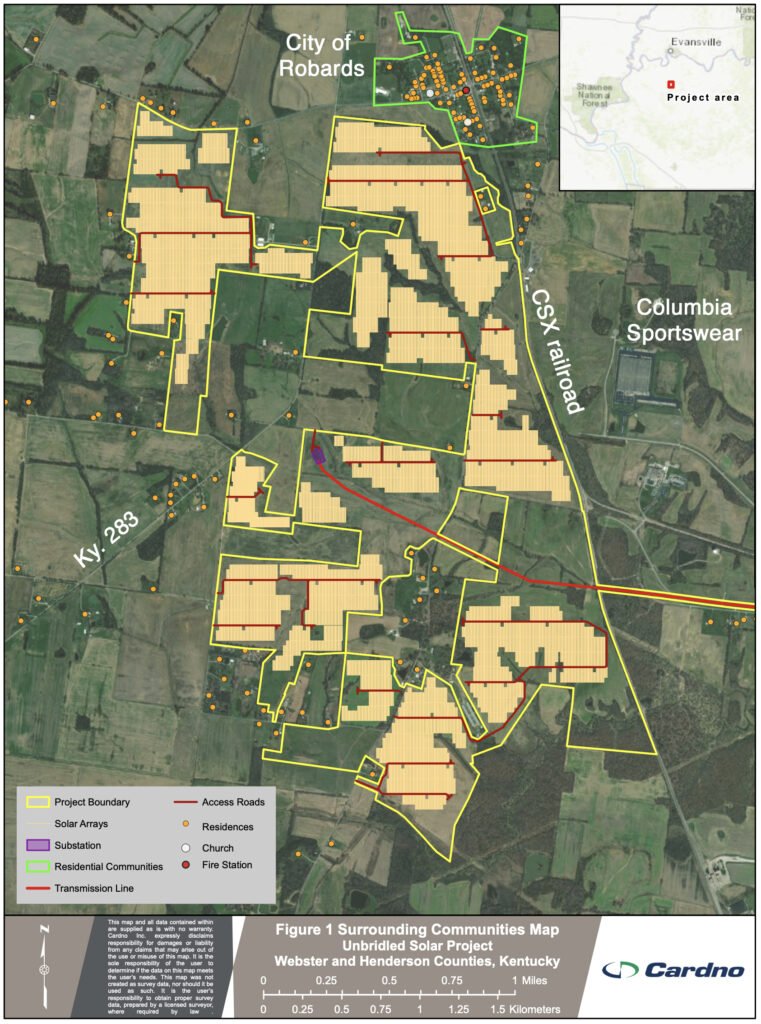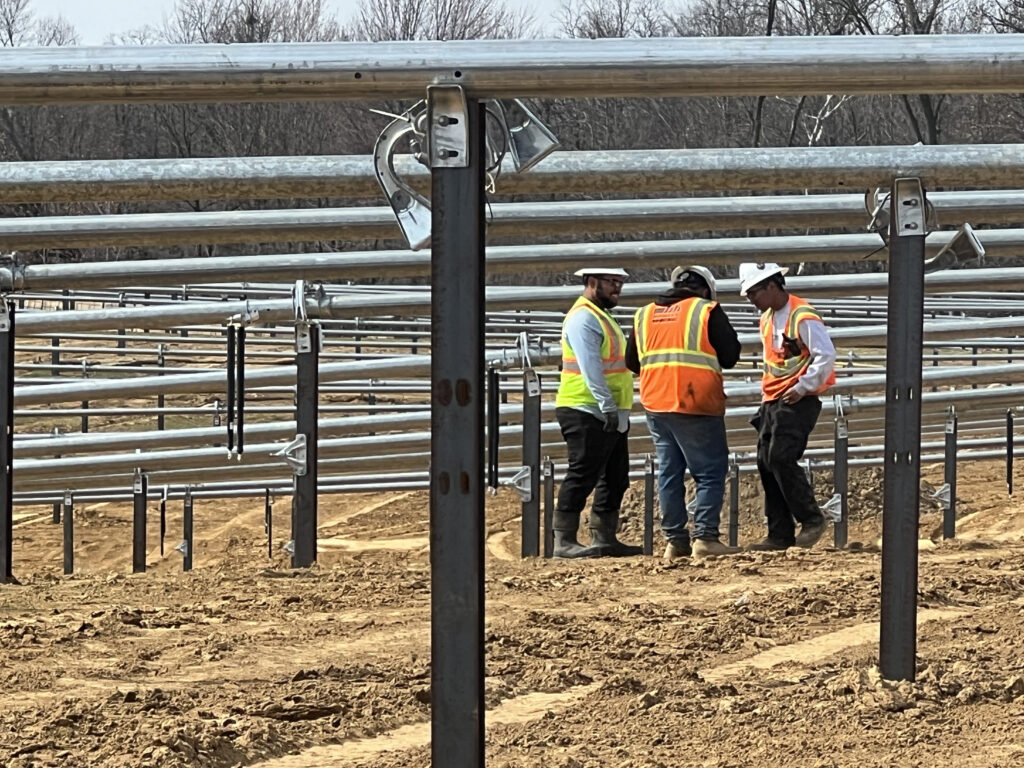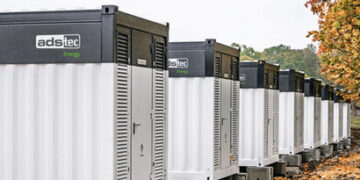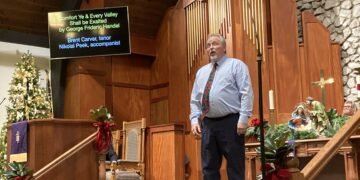(This article first appeared in the print edition published Feb. 28)
The gently rolling countryside south of Robards along the Henderson-Webster county line historically has been a sleepy area, tucked out of sight from nearby U.S. 41-South. Country lanes such as Pedler-McDonald Road and Old Knoblick Road have been traversed largely by farm trucks and tractors over the years.
But these days that area is a beehive of activity as construction of the 1,680-acre Unbridled Solar farm for National Grid Renewables has begun in earnest. The narrow roads are crowded with dump trucks, excavating equipment and company pickup trucks.
Some 155 construction workers are on the job now, and that will ramp up to 200 or more at peak construction, including some local workers with more to be hired (see details below).
The country air is punctuated with the staccato drumbeat of piledrivers pounding steel I-beam pilings into ground that once was turned over by plows.
“That is the most beautiful sound to me,” said Brent Pollard, project manager for construction contractor Wanzek Construction Inc. As long as he hears that sound, he knows that progress is being made.
How it works
As pilings are sunk, long metal pipes called torque tubes and other hardware are mounted to them. And as solar panels—some 400,000 in all, manufactured in Ohio and measuring 4-feet by 6.5-feet each—begin arriving in late February and early March, they will be mounted to the torque tubes. Motors will rotate the torque tubes and panels to track the sun from hour to hour and season to season.
The glass panels, which will convert sunlight to electricity, will be constructed of dark, light-absorbing materials with anti-reflective coatings. Allowing panels to reflect glare “would defeat the purpose,” said Lindsay T. Smith, a spokeswoman for National Grid. “We want to absorb as much energy as possible.”
The solar panels will be connected to wiring that will connect to electrical inverters that will convert their DC power to AC power. The inverters will be connected to a National Grid substation at the solar array; from there, a three-mile-long, 161-kilovolt transmission line will carry the solar-powered electricity to a Big Rivers Electric Corp. substation, and from there distributed to rural homes, farms, businesses and industries.
When it becomes operational by the end of this year, the Unbridled Solar array will, on sunny days, generate up to 160 megawatts (MW) of electricity. National Grid says that’s equivalent of 44,400 households’ average electrical usage.
“After operations (begin), this will go back to a sleepy town,” Smith said during a recent tour of the Unbridled construction site. Just a handful of full-time employees — a plant manager and some technicians — will be needed to oversee the sprawling solar array.
The land
Unbridled’s 1,680 acres includes 1,140 acres in Henderson County and 540 acres in Webster County. The various tracts will be secured by fencing and security cameras.
Smith said about 1/3 of that acreage has been purchased — chiefly the 419 acres it bought from the Four Star Industrial Park — while the remainder is leased from several landowners under long-term contracts.
One of those leasing ground to National Grid is Jim Vincent, who owns 86 acres of ancestral tillable land along Kentucky Highway-283.
“It’s been in my family since 1811,” Vincent said. “My great-great-great-grandfather came here in 1811 and bought 5,000 acres, from the Green River all the way to Robards.”
The prospect of having thousands of solar panels installed on ground his early ancestor plowed by mule did give him pause.

“The way I rationalized it was thinking, what would he have done with an opportunity like that?” Vincent said. “ … With the amount of revenue, it’s much greater than you could realize farming it. And the contract specifies that at end of the contract they have to restore it to the original condition.”
National Grid spokeswoman Smith said the vertical pilings can be pulled out of the soil at the end of Unbridled’s useful life; Vincent said his contract runs 30 years with two 10-year options to renew.
That helped Vincent discern what his ancestors might have done.
“I thought they would have done the same thing, given the revenue and given that it would be restored,” he said.
(Coincidentally, he said he has also leased a farm on the Green River in the Hebbardsville area to Cordelio Power, a Canadian company that is exploring the potential for erecting big wind turbines in that area for generating electricity. “There’s a lot going on with renewables around here,” Vincent said.)
The economic impact
National Grid hasn’t stated the investment it’s making in Unbridled. But last October, the Henderson County codes office issued a building permit for the project that valued the construction at $185.5 million, the biggest building permit ever issued by the county (without adjustment for inflation).
The company does say Unbridled will produce $42 million in direct economic impact over the first 20 years of operation, including wages to construction workers, $11 million in new property tax revenue and more than $24 million to local farmers and landowners. It plans $800,000 in local charitable giving over that same time period.
Economic impact from the construction phase is already being felt, from hotels housing out-of-town construction workers to area restaurants. Local workers have been hired and more could be.
“We’re open to hire,” spokeswoman Smith said. “We like to hire locally.”
The plant manager at National Grid’s Yellowbud solar project in Ohio, a longtime maintenance technician at a power plant, was hired from that community, she said.
Workers interested in construction jobs with Wenzak can apply online at careers.wanzek.com/wzk/jobs.
Current openings at the Unbridled construction site include solar technician, solar installer, local laborers and general interest laborer. Smith said being hired here could result in opportunities to work at other Wenzak construction sites around the country, as well.

The presence of scores of construction workers in the Robards area has benefitted the handful of small businesses near there, including the original Rockhouse Pizza on U.S. 41-South.
“Very much so,” said Jarrod Embry, general manager and partner at Rockhouse. “With the increase in contactors in the area, it has turned around and boosted our business a bit.”
He said it was also a factor in Rockhouse now opening at 5:30 a.m. Tuesday through Saturday for breakfast.
“It’s been great for the (adjacent) North-South Truck Stop and Sugg’s General Store (in downtown Robards), too,” Embry said. “Locally owned businesses have really turned around and benefitted.”
How solar fits in
Big Rivers, which will buy all of Unbridled’s power, will benefit as well, according to Nathan Berry, Big Rivers vice president and chief operating officer.
“Big Rivers believes in the all-of-the-above approach,” Berry said following a tour of the Unbridled construction site. Once, the vast majority of Big Rivers’ power came from coal-fired generating stations. But most of those aging plants have been retired or converted to burning natural gas.
Today, Berry said, “We want to have a diversified portfolio (of energy sources).”
Once Unbridled is in operation, he said, about 1/3 of Big Rivers’ power will come from carbon-free sources (solar and hydroelectric), 1/3 will be generated from natural gas turbines and 1/3 will come from coal plants, which he said provides the best low-risk option.
Once considered economically disadvantaged, the cost of installing and generating solar power, especially at a large, utility-scale, is now very competitive — often cheaper than coal-fired power, according to a 2023 analysis by global financial advisory firm Lazard.
“The renewable energy industry continues to grow and create economic opportunities for Americans, including new jobs, tax revenue streams and income opportunities for landowners and farmers,” National Grid’s Smith said. “Demand from customers, such as utilities and electric cooperatives, as well as corporations and organizations, remains high and solar continues to offer high value, low-cost electric generation, which is a benefit to everyone.”
National Grid said Unbridled will be a clean power source that will benefit the environment in multiple ways, including eliminating the release of 4.5 million metric tons of carbon dioxide — a climate-change contributing greenhouse gas generated by burning fossil fuels — over 20 years while eliminating consumption of 5.5 billion gallons of water use to generate steam in such power plants.
National Grid Renewables, based in Bloomington, Minn., develops, constructs, owns and operates renewable energy assets including solar, onshore wind and electricity storage. It says it has renewable energy projects under construction or in operation in seven states.
Big Rivers Electric Corp., based in Owensboro, is a member-owned, not-for-profit generation and transmission cooperative. It provides wholesale electric power and services to 120,000 rural customers across 22 counties in western Kentucky served by three distribution co-ops: Henderson-based Kenergy Corp., Paducah-based Jackson Purchase Energy Corporation and Meade County Rural Electric Cooperative Corp. of Brandenburg.



















